
Original Link: https://www.anandtech.com/show/2112
Intel's Core 2 Extreme QX6700: The Multi-core Era Begins
by Anand Lal Shimpi on November 2, 2006 2:14 AM EST- Posted in
- CPUs
After the incredible launch of Intel's Conroe earlier this year it's not too easy to follow that up, even if Intel is launching the world's first quad core desktop processor. The Intel Core 2 Extreme QX6700 is based on the new Kentsfield core, which we previewed not too long ago at IDF.
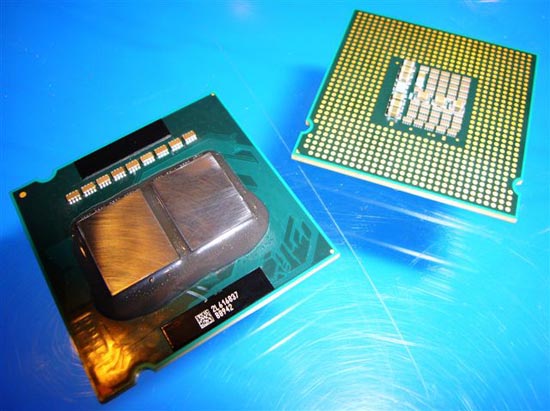
It's tough to tell a Kentsfield apart from a Conroe; although it sounds like a lot, 582 million transistors don't really feel any heavier than only 291 million (and it won't even sound like a lot after another week). With a heat spreader covering the flipchip cores, you can't tell that Kentsfield is nothing more than two Conroes placed on a single package. Much like Presler before it, Kentsfield is technically a quad-core processor with two separate die on the same package.

Core 2 Duo (left) vs. Core 2 Quad (right) - The only visible differences are the filter caps underneath the chip
We've shown in the past that there's no real world performance penalty to this approach to manufacturing, and there are numerous benefits from Intel's perspective. Yields are improved by producing a two die quad-core processor rather than a single die. The approach also improves manufacturing flexibility since Intel can decide at a very late stage whether to produce a dual or quad core processor after a die is fabbed.
| CPU | Manufacturing Process | Transistor Count | Die Size |
| AMD Athlon 64 X2 (2x512KB) | 90nm | 154M | 183 mm^2 |
| Intel Core 2 Duo | 65nm | 291M | 143 mm^2 |
| Intel Core 2 Quad | 65nm | 291M x 2 | 143 mm^2 x 2 |
| Intel Pentium D 900 | 65nm | 188M x 2 | 81 mm^2 x 2 |
The end result is you get 582 million transistors, built on a 65nm process, running at 2.66GHz for $999. You'll note that the price is equal to Intel's Core 2 Extreme X6800 with only two cores but running at 2.93GHz, and once again we're faced with the more cores or higher clock speed dilemma. In January 2007 Intel will introduce a slightly higher production model, the Core 2 Quad Q6600 running at 2.40GHz and a new $851 price point. Of course we'll benchmark both today.
| CPU | Clock Speed | L2 Cache | Price |
| Intel Core 2 Extreme QX6700 | 2.66GHz | 2 x 4MB | $999 |
| Intel Core 2 Extreme X6800 | 2.93GHz | 4MB | $999 |
| Intel Core 2 Quad Q6600 | 2.40GHz | 2 x 4MB | $851* |
| Intel Core 2 Duo E6700 | 2.66GHz | 4MB | $530 |
| Intel Core 2 Duo E6600 | 2.40GHz | 4MB | $316 |
| Intel Core 2 Duo E6400 | 2.13GHz | 2MB | $224 |
| Intel Core 2 Duo E6300 | 1.86GHz | 2MB | $183 |
| Intel Pentium D 945 | 3.40GHz | 2MBx2 | $163 |
| Intel Pentium D 915 | 2.80GHz | 2MBx2 | $113 |
| Intel Pentium D 820 | 2.80GHz | 1MBx2 | $93 |
| Intel Pentium D 805 | 2.66GHz | 1MBx2 | $93 |
*To be released in Q1 2007
More Cores, but where's the Elegance?
Architecturally, the two individual die that make up Kentsfield are treated as one. This distinction matters especially when you look at power consumption of the new processor. In the event that only one of the two die is being used, the other cannot simply power down; instead it has to run at the same voltage and frequency of the other active die. Within each die, the two cores have to run at the same frequency and voltage as well, so there's not really much flexibility in operation. The end result is that while Kentsfield doesn't use too much more power than Conroe when running four CPU intensive threads simultaneously given the additional work it is doing, when only running two threads, Kentsfield is quite wasteful with its power consumption.
A more efficient solution would be to allow each core to operate at its own frequency, and an even better implementation would require independent power planes per core - allowing for different voltages depending on load. As simple as these two options are to write, they are unfortunately far more difficult to implement. AMD has already announced that its Barcelona quad-core CPUs will support independent clock speeds per core, but not independent voltages.

AMD's Barcelona core, due out in Q2 '07, will have support for independent clocks per core but all sharing the same voltage
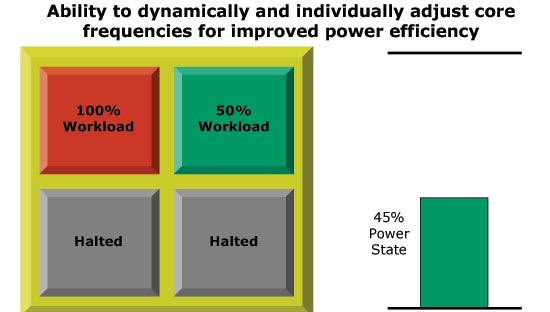
Using a Quad Core System
Intel's first dual core processors, codenamed Smithfield, were actually the first 90nm Intel CPUs we actually recommended. The reason being that the real world performance improvement brought about by having two cores at your fingertips was simply too much to resist, especially if you were a heavy multitasker. A big reason for the improvement in real world performance came about because of inefficiencies in the way Windows XP's scheduler handled juggling multiple threads, especially on a single core CPU. The move to dual core got rid of many of those nasty Not Responding windows when Windows' scheduler would simply never properly allocate CPU cycles to a particular thread.

Inevitably the same thread juggling problems we saw with single core CPUs would eventually apply to dual core CPUs, just with more active threads. Intel once told us that we'd run into the same sort of scheduler/CPU cycle limitations at a bit over a dozen active threads on a dual core CPU, meaning at that point, it's time for four cores.
We performed a quick test to see if we could spot the real world difference in multitasking and system responsiveness between a dual core and a quad core CPU. We took our test bed and ran as many multithreaded benchmarks as we could feasibly start without completely bogging down the system; we ran our 3dsmax, Cinebench, DivX, WME and iTunes tests all at the same time, not to see how fast they'd run, but to see how responsive the rest of the system would be with a dual core CPU vs. a quad core CPU.

On both systems we had no problems launching Explorer windows or navigating the OS while all of those tasks executed, indicating that we were no where near that saturation point where the entire system becomes unresponsive; good news for dual core owners.
We could switch between all of the running applications without running into a window that wouldn't respond, with the exception of iTunes. Regardless of whether we had two or four cores at our disposal, iTunes would only respond when it felt like it. Although the encoding task was continuing, we couldn't interact with the application without waiting a handful of seconds for it to regain consciousness.
The primary difference between two and four cores in our very heavy multitasking scenario was in the work that got done. While the 3dsmax, DivX, WME and iTunes tests all managed to inch along during our test, with a dual core setup the Cinebench test wouldn't even start until after iTunes had completed. On the quad core setup, Cinebench ran alongside iTunes, albeit at a slow pace.
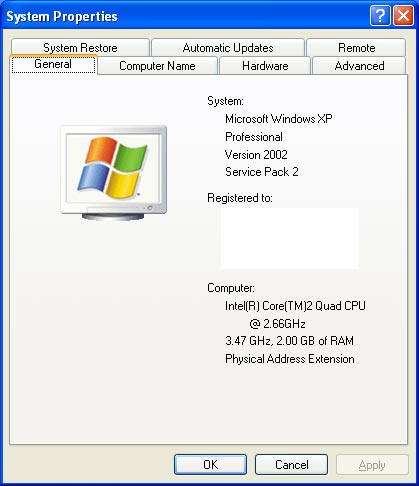
It's a faint difference but it does highlight an important point - even the heaviest of multitaskers aren't likely to see a huge difference in system responsiveness with four cores vs. two. It is in the performance of individual threads, especially when you have a lot that are contending for CPU time, that you'll see a much bigger difference between Kentsfield and Conroe.
More Cores - The Ticket to Power Efficiency?
When Intel started on its quest for greater power efficiency we heard much about how the ticket would be more cores and multi-threaded applications. Instead of focusing on increasing clock speed Intel turned to the world and admitted that its gigahertz race was foolish, and that the next decade of performance improvements would come from increasing the number of cores per processor, not clock speed.
Back in 2005 Intel displayed the following chart, plotting a new curve for performance made possible mostly by the move to multi-core processors:
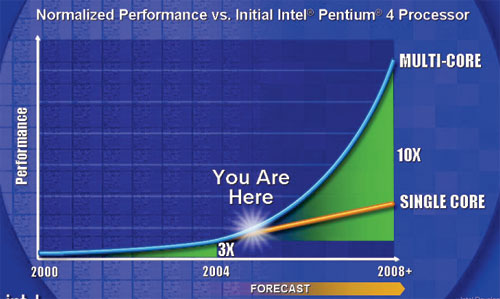
But at the same time, just as Intel had learned from the Pentium 4 family, an endless pursuit of performance (whether in the form of higher clock speed or more cores) will simply run us into another power wall. So as we were hearing about the performance improvements the multi-core era would bring us, we were also being told that Intel would not only improve the performance vector, but performance-per-watt as well. In fact, Apple cited Intel's focus on performance-per-watt as the driving factor in its adoption of Intel CPUs:
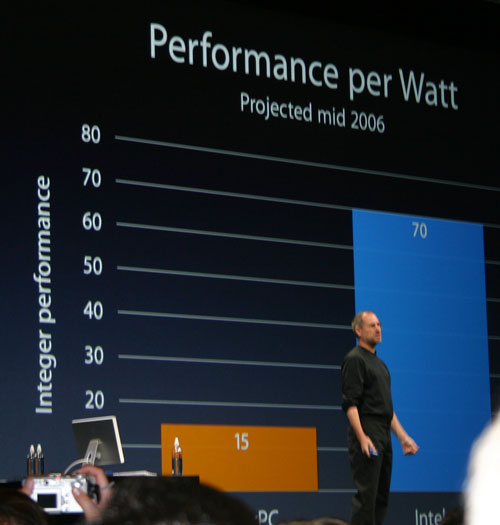
The introduction of Intel's Core microarchitecture proved one very important point: individual core improvements, as well as simply adding more cores, will both be necessary to drive better performance per watt in future microprocessors.
Looking at Intel's own numbers, the move from one to two cores improved performance per watt on the mobile side by around 50% while the move from NetBurst to Core on the desktop side increased performance per watt by a magnitude of 5x.
But is Kentsfield nothing more than a cleverly masked return to an older Intel? An Intel that used its manufacturing abilities to out-market AMD but left us with much higher power consumption than we wanted (and needed) to have? With Kentsfield we have two Conroes on a single chip, with no tweaks to the cores and very inefficient power management between the two die. Is this really no different than when Intel simply pushed out CPUs with higher clock frequencies, without addressing efficiency, to really turn up the heat on AMD?
Intel has said that it is committed to improving performance and performance per watt, but it was time to test that commitment with Kentsfield.
To put Intel's marketing and IDF presentations to the test we took six of our multithreaded benchmarks and ran them on a handful of configurations. Instead of just measuring performance, we also looked at average power usage during the benchmark and obviously, performance per watt. While all six benchmarks benefit from dual core CPUs, only four of them show a gain when using a quad core CPU, which should be useful in illustrating a very important correlation between number of threads and performance per watt.
Performance per Watt Comparison
3dsmax 7
3dsmax, like many 3D renderers, absolutely loves more cores and here we see Kentsfield maintain a tremendous performance advantage over Conroe. The scores reported are the SPECapc 3dsmax rendering composite in points, higher numbers being better, but the most interesting values are the performance per watt numbers.
Note: we are looking at system power draw rather than trying to isolate just the CPU. In that sense, we are comparing potential of running quad core configurations - i.e. in render farms and the like - instead of more dual core systems. Were we to get just the CPU power usage numbers, we would expect the usage of two identical cores in a single package to basically double power draw.
| CPU | Performance |
Average Power Consumption | Performance per Watt |
| Intel Core 2 Extreme X6800 (2.93GHz) | 4.11 pts | 192.5W | 0.0214 pts/W |
| Intel Core 2 Extreme QX6700 (2.66GHz) | 6.59 pts | 230.5W | 0.0286 pts/W |
| Intel Core 2 Duo E6700 (2.66GHz) | 3.77 pts | 189.2W | 0.0199 pts/W |
| Intel Core 2 Quad Q6600 (2.40GHz) | 5.96 pts | 225.9W | 0.0264 pts/W |
| Intel Core 2 Duo E6600 (2.40GHz) | 3.39 pts | 184.4W | 0.0184 pts/W |
| Intel Core 2 Duo E6300 (1.86GHz) | 2.68 pts | 176.1W | 0.0152 pts/W |
| Intel Core 2 Single Core (2.40GHz) | 1.85 pts | 174.1W | 0.0106 pts/W |
With higher performance and higher power consumption, the two manage to balance out and result in better performance per watt out of the two Kentsfield based parts than any of the dual core CPUs. While Kentsfield does require more power than Conroe, you get an even larger increase in performance thus resulting in a more efficient overall CPU.
Let's see if this is the start of a trend...
Cinebench 9.5
The Cinebench 9.5 test is also a multithreaded 3D rendering benchmark that will take advantage of as many cores as are present in the system. For each core, Cinebench spawns an additional renderer to help speed up the rendering of a static scene. Performance goes up by over 60% when moving from two to four cores, but once again it's the performance per watt that is particularly interesting:
| CPU | Performance |
Average Power Consumption | Performance per Watt |
| Intel Core 2 Extreme X6800 (2.93GHz) | 892 pts | 189W | 4.719 pts/W |
| Intel Core 2 Extreme QX6700 (2.66GHz) | 1337 pts | 225.1W | 5.939 pts/W |
| Intel Core 2 Duo E6700 (2.66GHz) | 816 pts | 186.1W | 4.384 pts/W |
| Intel Core 2 Quad Q6600 (2.40GHz) | 1216 pts | 219.8W | 5.532 pts/W |
| Intel Core 2 Duo E6600 (2.40GHz) | 751 pts | 181.8W | 3.973 pts/W |
| Intel Core 2 Duo E6300 (1.86GHz) | 582 pts | 175.4W | 3.127 pts/W |
| Intel Core 2 Single Core (2.40GHz) | 402 pts | 172.2W | 2.334 pts/W |
None of the dual core CPUs can come close to touching the power efficiency of the quad core Kentsfield based offerings.
DivX 6.1
Media encoding applications were the first to get a performance boost from dual core CPUs, but the impact is not nearly as great when we move to quad core processors. There's a gain of around 38%, which is by no means bad, just simply not as great as what we saw in the previous 3D rendering tests. The end result is that performance per watt is a lot closer between the most efficient dual core CPUs and the new quad core offerings:
| CPU | Performance |
Average Power Consumption | Performance per Watt |
| Intel Core 2 Extreme X6800 (2.93GHz) | 19.4 fps | 189.2W | 0.1027 fps/W |
| Intel Core 2 Extreme QX6700 (2.66GHz) | 24.8 fps | 223.7W | 0.1108 fps/W |
| Intel Core 2 Duo E6700 (2.66GHz) | 18.0 fps | 185.7W | 0.0968 fps/W |
| Intel Core 2 Quad Q6600 (2.40GHz) | 24.0 fps | 220.0W | 0.1089 fps/W |
| Intel Core 2 Duo E6600 (2.40GHz) | 16.3 fps | 183.0W | 0.0864 fps/W |
| Intel Core 2 Duo E6300 (1.86GHz) | 13.8 fps | 176.9W | 0.0745 fps/W |
| Intel Core 2 Single Core (2.40GHz) | 11.2 fps | 170.7W | 0.0658 fps/W |
If we look at performance per watt per transistor, Kentsfield is really not doing well here at all, despite an increase in performance and a continued advantage in performance per watt.
Windows Media Encoder 9
We see a much stronger showing from Kentsfield in the WME9 test, indicating that the DivX test was not representative of all media encoding on quad core.
| CPU | Performance |
Average Power Consumption | Performance per Watt |
| Intel Core 2 Extreme X6800 (2.93GHz) | 61.5 fps | 189.1W | 0.3252 fps/W |
| Intel Core 2 Extreme QX6700 (2.66GHz) | 86.4 fps | 223.2W | 0.3870 fps/W |
| Intel Core 2 Duo E6700 (2.66GHz) | 55.8 fps | 184.5W | 0.3025 fps/W |
| Intel Core 2 Quad Q6600 (2.40GHz) | 78.9 fps | 218.6W | 0.3608 fps/W |
| Intel Core 2 Duo E6600 (2.40GHz) | 50.4 fps | 181.8W | 0.2665 fps/W |
| Intel Core 2 Duo E6300 (1.86GHz) | 39.4 fps | 176.9W | 0.2137 fps/W |
| Intel Core 2 Single Core (2.40GHz) | 31.3 fps | 171.7W | 0.1822 fps/W |
Quicktime (H.264)
Interestingly enough, our Quicktime H.264 test didn't show any performance improvement going from two to four cores, indicating that the encoding process is optimized for two threads. Quicktime thus becomes the posterchild for what's necessary for the multicore revolution to truly bring about greater power efficiency: better threading within applications.
| CPU | Performance |
Average Power Consumption | Performance per Watt |
| Intel Core 2 Extreme X6800 (2.93GHz) | 30.0 fps | 191.2W | 0.1569 fps/W |
| Intel Core 2 Extreme QX6700 (2.66GHz) | 27.5 fps | 210.0W | 0.1309 fps/W |
| Intel Core 2 Duo E6700 (2.66GHz) | 27.5 fps | 188.1W | 0.1461 fps/W |
| Intel Core 2 Quad Q6600 (2.40GHz) | 25.2 fps | 207.0W | 0.1216 fps/W |
| Intel Core 2 Duo E6600 (2.40GHz) | 26.5 fps | 185.1W | 0.1430 fps/W |
| Intel Core 2 Duo E6300 (1.86GHz) | 19.8 fps | 177.7W | 0.1113 fps/W |
| Intel Core 2 Single Core (2.40GHz) | 16.2 fps | 170.6W | 0.0951 fps/W |
Here the dual core offerings are clearly superior when it comes to performance per watt simply because the Kentsfield CPUs aren't able to outperform them, all while using more power. The efficiency wouldn't be a problem if Kentsfield was able to power down unused cores independently of one another.
iTunes MP3
Our final test is yet another benchmark that only spawns two encoding threads, and we get another example of how power efficiency falls off if the software is not threaded enough to match the CPU's resources.
| CPU | Performance |
Average Power Consumption | Performance per Watt |
| Intel Core 2 Extreme X6800 (2.93GHz) | 11.7 MB/s | 193.4W | 0.0605 MBps/W |
| Intel Core 2 Extreme QX6700 (2.66GHz) | 10.9 MB/s | 213.1W | 0.0509 MBps/W |
| Intel Core 2 Duo E6700 (2.66GHz) | 10.5 MB/s | 188.3W | 0.0557 MBps/W |
| Intel Core 2 Quad Q6600 (2.40GHz) | 9.8 MB/s | 206.8W | 0.0474 MBps/W |
| Intel Core 2 Duo E6600 (2.40GHz) | 9.8 MB/s | 185.4W | 0.0529 MBps/W |
| Intel Core 2 Duo E6300 (1.86GHz) | 7.6 MB/s | 177.0W | 0.0429 MBps/W |
| Intel Core 2 Single Core (2.40GHz) | 6.1 MB/s | 168.4W | 0.0361 MBps/W |
Analyzing Efficiency Trends
The graph below summarizes the data pretty well; what you're looking at is a graph of normalized performance per watt in six applications as a function of the number of cores in a Core micro-architecture CPU:

The graph illustrates exactly what we've confirmed here today: having more cores does increase efficiency if the software is designed to take advantage of those additional cores.
We have not yet hit the point of diminishing returns with adding more cores, but the two downward trending curves show the current problem with scaling from two to four cores. Very few desktop applications can take good advantage of a dual core CPU and even fewer are geared for quad core chips, and in those applications these quad core processors are actually a step back in terms of efficiency; it's not a fault of the processor, but rather of the software.
Through the benchmarks on the previous page we also highlighted another important point to take away: even in the areas where performance and efficiency were both improved, they came at a very expensive cost: twice the transistor count of Core 2 Duo. As much as Intel may call the next decade the era of multi-core and thread level parallelism, we simply can't lose focus on improving instruction level parallelism and core level efficiency.
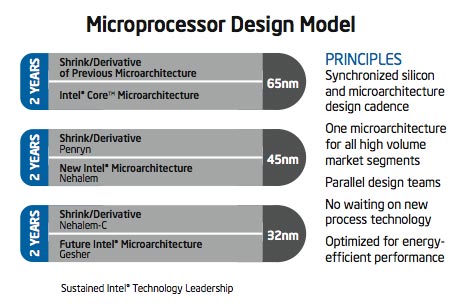
Thankfully Intel has recently announced that it will be updating its micro-architecture every two years in an attempt to avoid problems like what happened with NetBurst and the Pentium 4. If it weren't for this change in microprocessor design model, the quest for more cores would end up no differently than the gigahertz race.
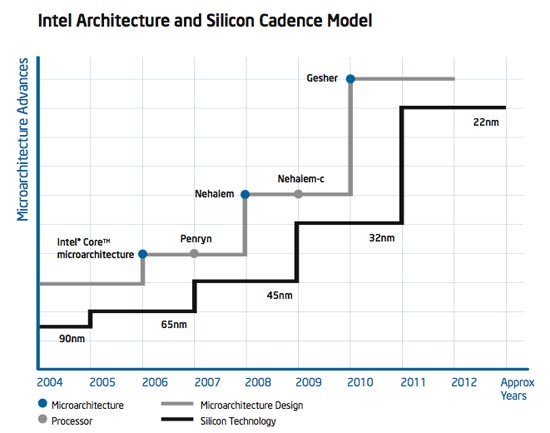
If all goes according to plan, it looks like we will get one of those improvements to ILP and core efficiency by the end of 2007/beginning of 2008 with Nehalem in order to avoid hitting another efficiency brick wall.
Power Efficiency Through Better Software
We've just established that more cores can give us better power efficiency and performance, but there's one giant requirement for that: software must be written to take advantage of the many cores at its disposal. Being multithreaded alone is not enough, as we saw from the Quicktime and iTunes encoding tests; both benchmarks are multithreaded, but we only saw an increase in performance and power efficiency on dual core CPUs, not on quad core CPUs.
Microsoft's upcoming Windows Vista and associated Vista applications will begin pushing for better performance on multi-core systems. Even Microsoft's Office 2007 is multithreaded and of course anything encoding related is generally well threaded these days. Apple's OS X and its applications have also been well threaded for quite some time, and it's very possible that Apple itself may want to embrace Kentsfield in order to drive costs down on its Mac Pro line of systems.
And what about gaming? Even our multithreaded Quake 4 benchmark doesn't show a performance increase when going from two to four cores, and it's one of very few games that actually takes advantage of multiple cores. Without significant re-writes of today's games we're not going to see the sort of power efficiency improvements that we need in order to drive performance forward. Remember that AMD and Intel are banking on heavily multithreaded code in order to actually drive CPU performance ahead in the coming years; without the appropriate software, CPU performance would effectively stagnate.
Thankfully it looks like 2007 will mark the beginning of threaded games making a significant impact on the PC market. Back at this year's fall IDF we spoke with Remedy's Markus Maki and Lasse Seppanen about the engine behind Alan Wake, and were surprised to find out that currently the game isn't even expected to run on anything less than a dual core (or single core + HT) platform.

Remedy's Alan Wake
As we mentioned in our IDF coverage, Alan Wake currently spawns five independent threads: one each for rendering, audio, streaming, physics and terrain tessellation. Both the rendering and physics threads are heavy hitters and those two alone have the potential to eat up a dual core CPU, but the additional threads are what may improve the gaming experience on a quad core CPU.

Unreal Tournament 2007, based on the Unreal Engine 3, will utilize multiple cores
Given that Alan Wake is clearly targeted for multi-core CPUs, we wanted to hear from another developer for a bit of a reality check to see where some of the next-generation of PC gaming is going. With their highly anticipated Xbox 360 title, Gears of War, on the verge of shipping we were lucky enough to get some information on Unreal Tournament 2007's thread usage from Tim Sweeney, Founder and President of Epic Games.
We asked Tim to tell us a bit about what threads UT2007 will spawn, and he responded with the following:
"Currently Unreal Engine 3 runs two heavyweight threads all the time: one for gameplay and one for rendering. In addition, there are several helper threads to which we offload all of the physics (using Ageia's multithreaded PhysX library), streaming, and several other tasks.
We plan to extend the threading support further in time for the release of Unreal Tournament 2007 next year, to further exploit multi-core PC CPUs. Major opportunities for multithreaded optimization include particle systems, animation, and terrain. Also, since UT2007 uses very extensive vehicle and ragdoll physics, we expect that at peak times during gameplay that we'll have no trouble fully exploiting 4 threads at the maximum detail settings.
There are lots of other interesting prospects. I expect we'll be able to exploit as many cores and Intel and AMD are able to ship in the foreseeable future."
It looks like by the time UT2007 makes its appearance on the PC it will be juggling, at times, more than two CPU intensive threads. Tim added one more comment that was particularly interesting: UT2007 will not require a dual core CPU, meaning there's still life for single core in gaming, even in the 2007 - 2008 timeframe.
Despite the relatively gung-ho attitude by Remedy, Epic and other ISVs on being able to use more than two cores regularly, the fact of the matter is that neither Alan Wake nor UT2007 are coming out anytime soon. And it's tough to say how long before other titles actually show a noticeable performance or experience difference between two and four core CPUs. Our pragmatic side can't help but point out that if you're building a high end gaming PC today, going quad-core will help in the future, but we can't really say precisely when that future will be.
Overclocking
When Intel's first dual core CPUs hit the market, there was a significant gap in clock speed between them and the fastest single core CPUs. The fastest dual core Pentium Extreme Edition was introduced at 3.2GHz, while you could get a 3.73GHz single core CPU for similar money. The single core Pentium 4 Extreme Edition had a 16.5% clock speed advantage, that you had to give up in order to get a second core at the high end.
Of course back then, clock speed mattered, and it was frequency that got you reasonable performance out of Intel's NetBurst architecture. You gave up much less if you looked at the AMD side of things; their fastest single core CPUs at the time ran at 2.6GHz while the fastest dual core Athlon 64 X2s ran at 2.4GHz.
With Intel's Core microarchitecture, the situation with Kentsfield vs. Conroe is much more like the Athlon 64 vs. Athlon 64 X2. At $999 you've got a dual core 2.93GHz offering or a 2.66GHz quad core offering, and at that price point the decision isn't too hard to make, especially when you take into account that you can overclock Kentsfield pretty well.
Like all other Core 2 Extreme processors, the QX6700 has a mostly unlocked clock multiplier, allowing you to easily overclock to higher frequencies. So while you can't take a Core 2 Extreme X6800 and give it more cores, you can always take a QX6700 and run it at X6800 speeds to have your cake and eat it too.
We managed to get our QX6700 sample up to 3.2GHz (12 x 266MHz) at the CPU's stock voltage of 1.35V, which isn't bad at all considering we didn't employ any exotic cooling. Bumping the core voltage up to 1.3875V we were able to gain an extra 266MHz and run at 3.46GHz.
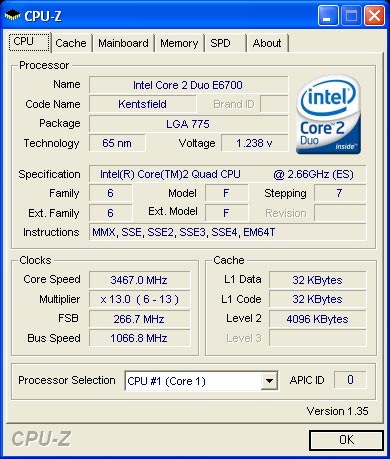
You lose some overclocking headroom given the added heat output of the extra die on the chip, not to mention that both die have to be capable of running at the overclocked speed, but overall Kentsfield doesn't look too bad as an overclocker's chip. It's not the bang for your buck that the E6300 offers, but at $999 that's not what we're expecting to begin with.
The Test
Given what you've already seen, you should already have a good idea of how Intel's Core 2 Quad processors will perform. In applications where you have more than two CPU intensive threads, Kentsfield can do quite well, but otherwise it will perform more or less the same as an equivalently clocked Core 2 Duo.
Our usual benchmark results follow on the coming pages.
| CPU: | Intel Core 2 Extreme X6800 (2.93GHz/4MB) |
| Motherboard: | Intel BadAxe2 (LGA-775) |
| Chipset: | Intel 975X |
| Chipset Drivers: | Intel 7.2.2.1007 (Intel) |
| Hard Disk: | Seagate 7200.9 300GB SATA |
| Memory: | Corsair XMS2 DDR2-800 4-4-4-12 (1GB x 2) |
| Video Card: | 2 x ATI Radeon X1900 XT in CrossFire |
| Video Drivers: | ATI Catalyst 6.7 |
| Desktop Resolution: | 1280 x 1024 - 32-bit @ 60Hz (1600 x 1200 for games) |
| OS: | Windows XP Professional SP2 |
Application Performance using SYSMark 2004 SE
No article looking at a new processor release would be complete without benchmarks. However, let us preface the benchmark section by stating that the benchmarks don't tell the whole story. There are numerous benchmarks and tasks that you can run that will actually show quad core processors in a better light. A lot of people will never use the applications related to these benchmarks, so in one sense we could say that most people should already know whether or not they need quad core processing. There is also definitely an element of future proofing your system by purchasing quad core now, with the hope that it will be more useful at some point during the life of the system. We definitely do not expect to see large gains in performance in most of the benchmarks we will run, simply because they were not designed or optimized to run on multi-core systems. We will also have some benchmarks that clearly do show vast improvements by moving from dual cores to quad cores, although we've already seen coverage of this in our Kentsfield preview.

We'll start with SYSmark 2004, a benchmark suite that does have some multitasking components and multithreaded applications, but which also includes plenty of work that benefits very little from dual cores let alone quad cores. The overall scores show the quad core processors to basically be equal to their dual core counterparts in terms of performance, with the margin of error accounting for the slight differences in score. Having two more processor cores did almost nothing for SYSmark 2004, and we would expect that to be the case with many business/office applications. Drilling down into the individual results gives us a bit more information, however.
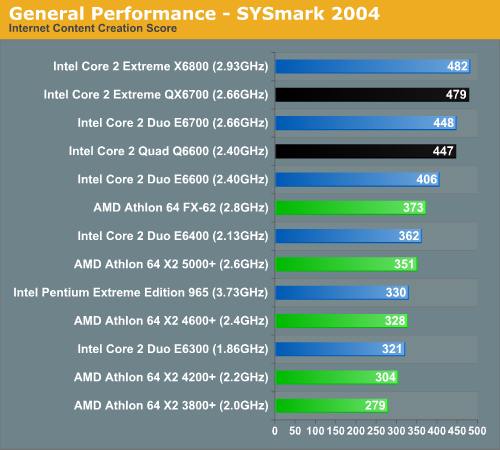
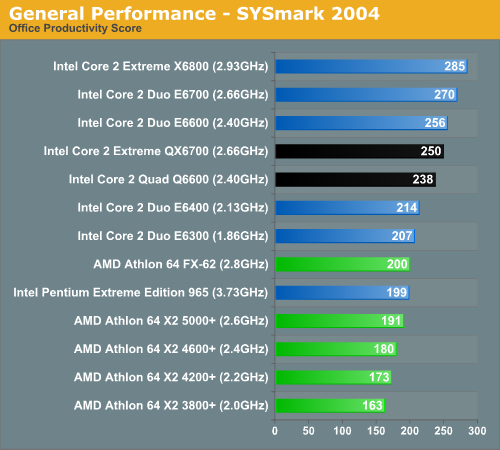
The Internet content creation score clearly does benefit by adding extra processing cores, although not a lot. The Core 2 Quad systems are more or less able to match Core 2 Duo chips clocked one bin higher. The Office Productivity scores show the exact opposite: Core 2 Quad chips are slower than Core 2 Duo chips with the same clock speed. In an ideal world, this shouldn't happen, as all other things being equal having more processor cores should not slow down your overall performance. At some low level, however, there appears to be some resource contention or operating system inefficiencies. The SYSmark 2004 overall score is a good representation of what the end-user will truly experience for this sort of application: the difference between dual cores and quad cores really isn't very apparent if you are a more or less "typical" user.
Application Performance using PC WorldBench 5

WorldBench 5 is almost completely singlethreaded in nature, so here the extra processor cores do virtually nothing. The 2.4 GHz Q6600 scores the same as the 2.4 GHz E6600, and the same goes for the 2.67 GHz chips.
Application Performance using Winstone 2004
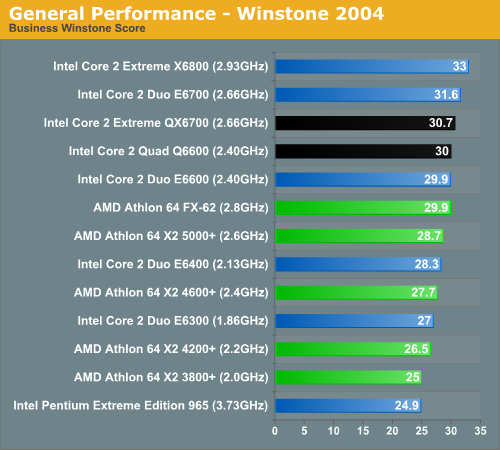
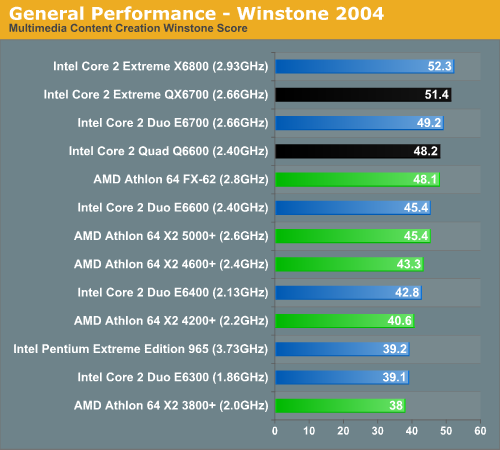
Winstone 2004 is also mostly single threaded applications, although the Internet Content Creation portion of the benchmark does include a few multithreaded applications. In all three of these benchmarks (SysMark, WorldBench, and Winstones), there really isn't much benefit to quad core processors, but there also isn't any real penalty. This is pretty much what we would expect.
3D Rendering Performance using 3dsmax 7 & CineBench 9.5
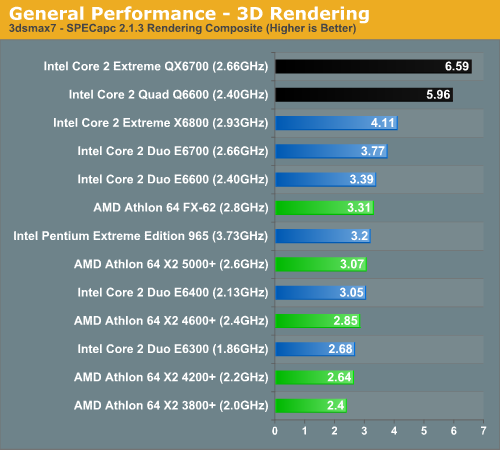
If there's one area where multi-core processors are almost guaranteed to shine relative to single core and even dual core processors, 3D rendering applications are it. 3D Studio Max shows a 75% performance increase relative to dual core processors, the multi-core Cinebench test shows about a 63% improvement.
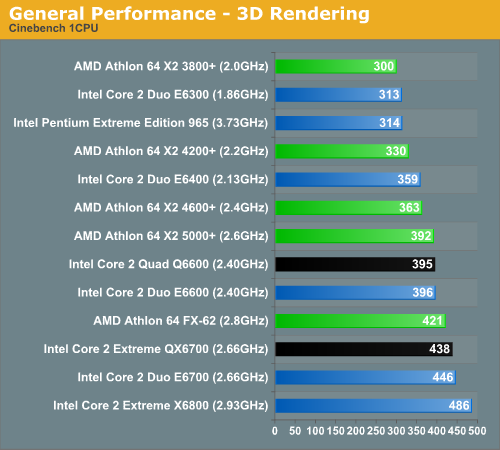
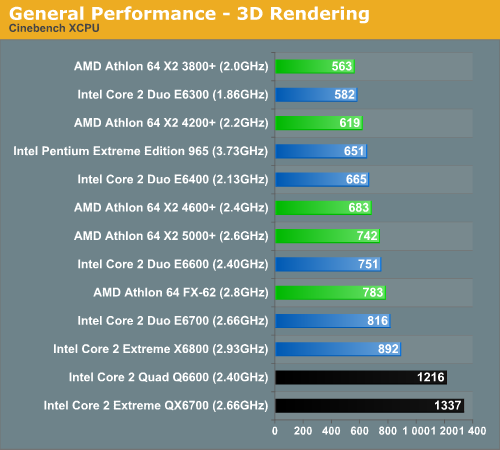
Encoding Performance using DivX 6.1, WME9, Quicktime (H.264) & iTunes
Although to a lesser degree than 3D rendering applications, encoding apps benefit very well from moving to more cores. DivX and Windows Media Encoder show a ~40%-55% improvement while QuickTime's H.264 encoding shows basically no benefit, and neither does MP3 encoding. There is certainly potential for either task to be further optimized for multi-core architectures, and hopefully we will see that in future versions of the software, but without proper programming support, even tasks that could potentially make great use of quad core processors will show little to no benefit.
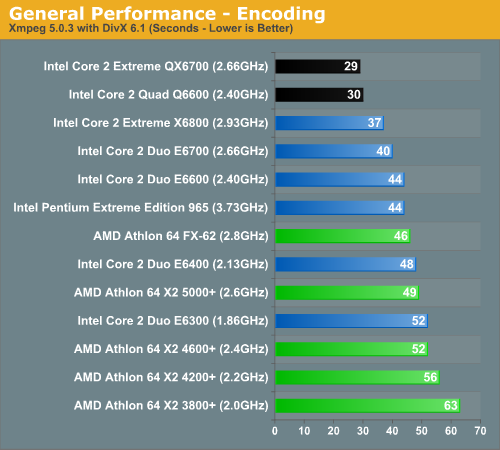
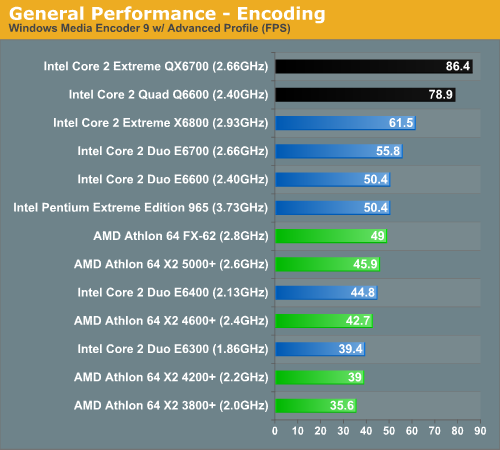
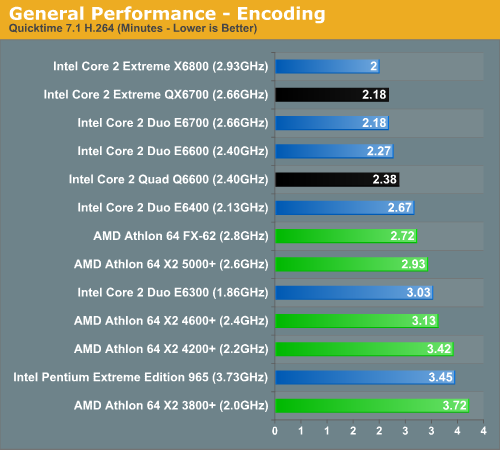
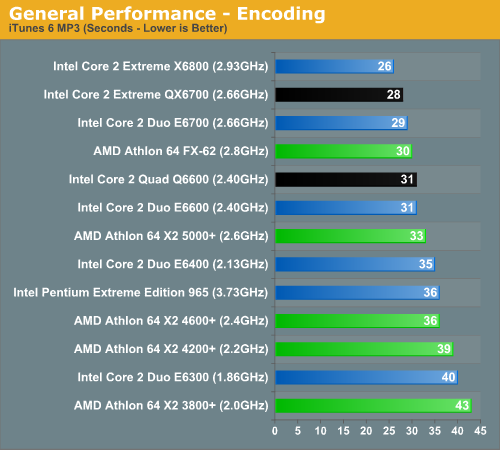
Gaming Performance using Quake 4, Battlefield 2 & Half Life 2 Episode 1
We will wrap up with gaming performance benchmarks. If you expect to find something exciting with the currently available software, prepare to be disappointed. There are slight variations in the benchmark scores, but most differences can be accounted for by the margin of error in running each test. Even those applications which do have rudimentary SMP support show no advantage from having more than dual cores.
As an example, our understanding is that the threading approach used in Quake 4 consists of separating the client and server threads and running each system as a separate thread. This is known as coarse grained threading and it represents one of the easiest approaches to making an application multithreaded. Unfortunately, as is the case here, coarse threading often results in limited performance improvements. A system is only as fast as its slowest component, and in the case of Quake 4 the client thread still does the vast majority of work, including all the graphics and sound rendering. The end result is that even with high-end graphics cards, you still quickly become GPU limited.
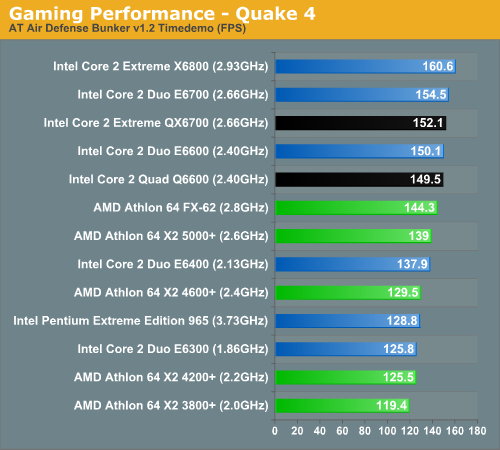
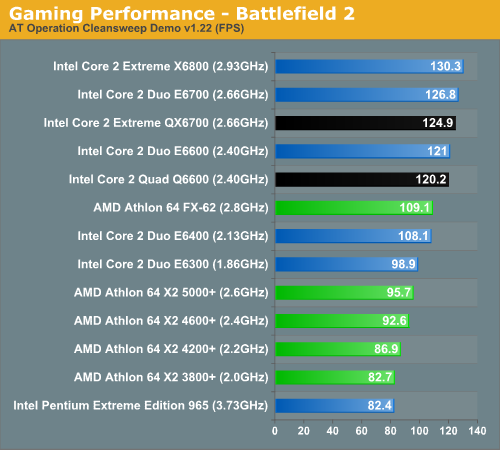
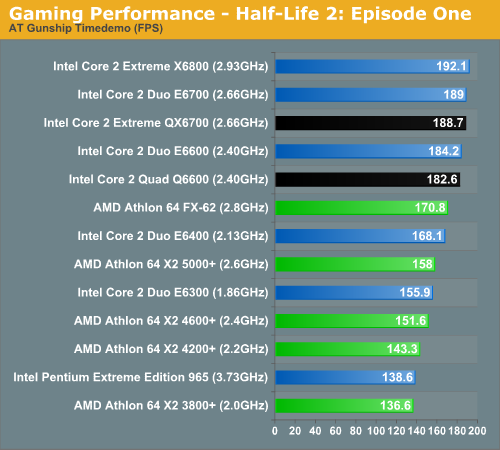
Gaming Performance using F.E.A.R. & Rise of Legends
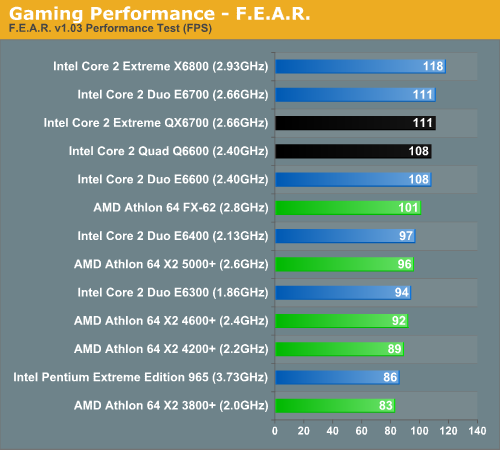
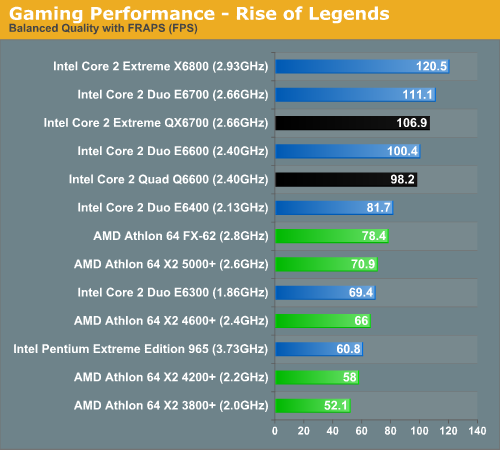
Gaming Performance using Oblivion
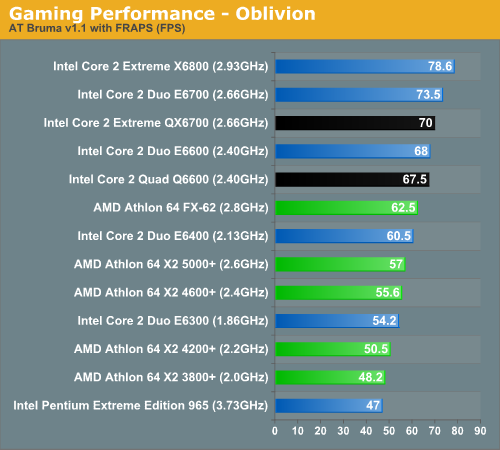
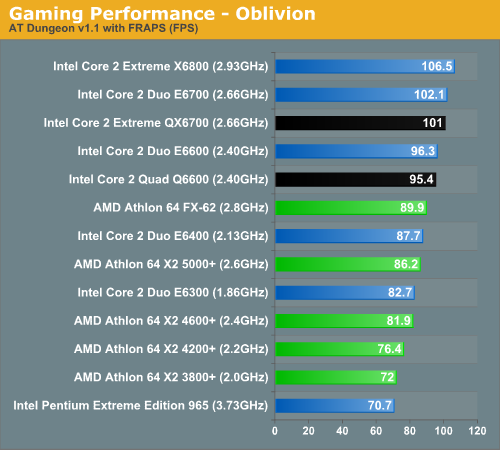
Final Words
Before we can really start to embrace greater than dual-core CPUs we'll need to have heavily threaded software, and thankfully it's looking like that software is well in development. Windows Vista and applications that ship for the new OS will be some of the first developed for a largely multi-core user base, not to mention that there are many game titles under development with support for multi-core. These days you almost have to try to avoid a dual core CPU when building or buying a new system, and it wasn't much more than a year ago that we were debating the merits of single vs. dual core. The debate begins anew with the release of Intel's Kentsfield core, although now we're talking about two vs. four cores.
The problem with gaming benchmarks is that they often lag behind the hardware. All of the games we're testing today are at least a few months old, and while it would be nice to have more titles that can take advantage of at least dual core processors, the challenges involved in building a game engine that can truly take advantage of multiple processor cores are difficult to overcome and require a lot of time. We are aware of at least three companies that are working on engines that will benefit from CPUs with more than two cores, however, and hopefully more companies will follow suit in the future. The "dual core revolution" is not yet two years old, and the majority of modern games require more than two years to design and develop. There has been a great focus on improving game graphics over the previous decade or more, but it looks like we may finally be reaching the point where other aspects of gameplay are becoming important, and in order to flesh out those other areas (physics, artificial intelligence, particle systems, number of entities, etc.) multiple processor cores have a lot of potential.
If you're the type of person that likes to participate in projects like Folding@Home, or if you do a lot of video rendering, 3D rendering, or some other task that can be easily parallelized, you might already be running a dual socket configuration with dual core processors. Quad core takes the benefits of such an offering and packages it into a single socket, and in the near future dual sockets will be able to move up to eight cores. The gaming results clearly didn't show any advantage to multi-core processors right now, beyond the moderate speed up a couple games gained with dual cores. However, there are plenty of gaming companies that are working on re-architecting their software in order to take advantage of not just two or four cores, but potentially any number of cores. Will they succeed? We have an upcoming article that will look at one company's work in the very near future, but suffice it to say there's definitely a lot of potential in multi-core platforms.
If you're stuck between choosing a Core 2 Extreme X6800 or QX6700 at $999, we'd obviously opt for the latter. Both give you incredible performance, but one is a bit more future-proof. And, as we said earlier, you can always overclock the QX6700 but you can't add more cores to the X6800. The best CPU buys are still going to be the E6300, E6400 and E6600, which are unfortunately "only" dual core solutions. Despite being only dual core offerings, all three are still some of the fastest performing desktop CPUs money can buy today.
With only a single $999 part, and even taking into account January's $851 Core 2 Quad offering, quad core is not going to be mainstream anytime soon nor are most applications ready for it. It's also worth mentioning that there's no point in waiting to upgrade to the Q6600, after all the difference in price between the $999 QX6700 and the $851 Q6600 isn't that much, especially when you consider that you'd have to wait an additional 2 - 3 months before the Q6600 makes its debut. Now if the street price of the QX6700 ends up being much higher than its 1Ku pricing then the Q6600 may end up being worth waiting for.
Looking towards the future, gaming will be going multi-core partially because of the fact that if you want to get good CPU performance on the next-generation consoles the developer needs to make good use of all available cores (consoles breed efficient programmers). From the descriptions that Remedy and Epic have given us, it looks like dual cores are a clear winner in the next generation of games, and quad core may be what's necessary to get that extra level of smoothness or detail when it comes to terrain or physics simulation. We don't expect dual or quad core to be necessary for gaming anytime in the next 9 months but before 2007 is over expect to see some very enticing titles that make good use of that second core. Four cores will eventually be utilized, but it's tough to say to what degree until the time is upon us. Our expectations put quad core as being a fringe benefit in 2007 but more of a tangible ally in games by the time '08 rolls around.
Workstation users can rejoice however as most workstation apps are very well threaded and because you can now build an extremely powerful workstation using nothing more than desktop parts. You get CPU performance that used to require a very expensive motherboard and registered memory in the same machine you use for everything but work. Obviously the new target for workstations will be eight cores through two sockets, but if you don't quite want that much processing power there's this new category of home workstation PCs that's created by Kentsfield.
And what about AMD? As expected, 2006 has turned out to be Intel's comeback year, and it won't be until the introduction of Barcelona in the middle of 2007 until we really see a performance competitive AMD. Of course AMD's 4x4 has yet to launch, and while it will be a monstrous platform, it will be even more of a niche product than Intel's $999 Kentsfield. While Kentsfield will work in many currently shipping Core 2 motherboards, 4x4 is an entirely new platform using Socket-1207 (not AM2) CPUs. As much as AMD wants 4x4 to succeed, what we're really waiting for is Barcelona.







